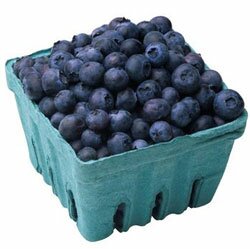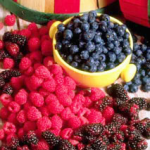
Some winter blues are good.
As we reported in our earlier Blog feature regarding the wonderful brain health and anti-aging properties of blueberries, we know it's a good thing to get a daily dose of this blue-colored antioxidant superfood. But many of us also know that it can be very hard (and expensive!) to find blueberries off-season such as during the winter months, resulting in many simply stopping their intake until blueberries start appearing on the grocery store shelves at reasonable prices again.
Sound familiar?
Well, there's no need to deprive your brain and body just because you can't get blues all the time. You can indeed stay blue (and red), all winter long.
The reality is that blueberries are most definitely not the only game in town when it comes to what makes them great, and you may be surprised to hear just how easy (and cost-efficient) it really is to get your blue/red powerhouse antioxidant foods to keep your brain and body healthy, no matter where you live in the world, all year long.
But first, a bit of info on blue (and red) and just what makes some of these superfoods "super": anthocynanins.
You may have seen this word on the back of some health food or juice products or perhaps in the news, and it's one to remember; anthocyanins are ultra-powerful antioxidant flavonoids that possess some of the strongest physiological effects of any plant compounds. They also give plants & fruits their blue-to-red colors, which makes it relatively easy to spot anthocyanin-rich edibles. And fortunately, there are enough anthocyanin-rich foods out there around the world that you should be able to find at least one to replace blueberries (or other seasonal anthocyanin-rich foods) during the off seasons.

Why anthocynanins? Because they posses such diverse health benefits:
Multiple studies, including the Jan. 2006 study from the Journal of the Science of Food and Agriculture, have shown the positive health benefits of anthocyanins across a range of health conditions, and one primary factor is their anti-inflammatory properties which affect collagen and the nervous system: they help to neutralize enzymes that destroy connective tissue, and their antioxidant capacity prevents oxidants from damaging connective tissue while repairing damaged proteins in the blood-vessel walls. These have been shown to:
- Help the brain: as the brain is particularly vulnerable to oxidative damage, anthocyanins help protect our brain tissue lipids from oxidation, which in turn fights degenerative brain diseases while helping to protect the brain from such oxidative stress. One study even found anthocyanin-rich supplements to reverse age-related neurological deficits in animals.
- Help dampen allergic reactions. In one study, Bulgarian researchers gave animals histamine and serotonin, both of which cause allergic reactions and increase capillary permeability. The animals were supplemented with a variety of flavonoids. Anthocyanins were found to have the strongest anti-inflammatory effect of any flavonoid tested.
- Reduce cardiovascular diseases: anthocyanins protect the integrity of the cells that line blood-vessel walls. A study by the USDA at Tufts University in Boston found that anthocynanins in such fruits as elderberry and bilberry have "important implications on ... vascular diseases".
- Diabetes: damage from high blood-sugar levels causes most of the complications in diabetes. In one German study, Collagen proteins become linked with sugars, resulting in abnormal polymeric blood vessel collagen. Recent German and French studies showed that diabetics given anthocyanins saw significant reduction in abnormal collagen production and a normalizing effect on microcirculatory function, illustrating the powerful benefits of anthocyanins for diabetics and those wishing to avoid getting diabetes in the first place.
- Eyesight and blindness: one of the most serious diabetic complications is retinopathy, which can cause blindness. Anthocyanins help prevent this by preventing capillaries from leaking in the first place, and also prevent abnormal protein proliferation, in addition to improving eyesight by other mechanisms. - Anti-cancer: anthocyanins have been found to inhibit some human tumor cells.
- Ulers: Bilberry, traditionally used for ulcers, may increase the production of stomach mucus and protect the stomach from injury.
And now for the list of foods: what are the foods that contain the highest amount of anthocyanins? We already know about blueberries, but most other berries also contain comparatively high amounts of anthocyanins, particularly:
- Blackberries
- Blackcurrant
- Chokeberry (also known as aronia berry)
- Bilberry
- Blue grapes
- Elderberries
- Pomegranates
- Red wine (due to dark-skinned grapes)
- Red apples
- Cherries
- Strawberries
- Raspberries
- Other berries with dark red or blue-black coloring
Also, vegetables such as red cabbage and eggplant (the dark purple-black skin of the eggplant is a good indicator) contain anthocyanins.
Now, of the above list of berries, blackberries, blackcurrants and chokeberries generally contain the highest amounts of anthocyanins and overall antioxidant horsepower, with some studies showing blackberries and blackcurrants to contain even higher (much higher) amounts than even blueberries.
But common sense steps in here: there's no one single miracle berry or vegetable, so if you can consume a variety of these berries and vegetables in addition to an overall healthy, diverse diet, you'll be most likely to get enough of the numerous benefits that each of these foods possesses. And you'll make it easier on yourself when you can't find one or more of them at the grocery store, too.
But where am I going to find those weird berries such as blackcurrant or bilberry or chokeberry or pomegranates in my town, you say?
True, in some places, it's difficult to find any of the above list of berries or vegetables, fresh. That's where juices come in: fortunately, numerous companies around the world now offer 100% pure, unsweetened, minimally processed juices of these berries, now even in combination, making it easy to get a good dose of daily anthocyanins almost anywhere. Whether at your local supermarket, natural foods or health food store, you should be able to find bottled (either fresh/refridgerated) or glass-bottled juices such as blackberry juice, blueberry juice, blue grape juice, pomegranate juice, and many combination juices.
The key is to find unsweetened, ideally organic and "fresh-pressed" juices that contain nothing but 100% pure juice, so it's important to read the labels(!) as some bottled juices are heavily sweetened and processed.
So, although you don't get quite the full benefits of eating the whole raw berries themselves (giving you the full fiber and completely fresh unadultered berry), bottled juices are the next best thing, particularly if it means getting your anthocyanins all year long or not getting them at all. You can also do a combination of some fresh sources and some juice, such as eating eggplant, dark raspberries and blue grapes but drinking bottled blueberry, blackcurrant or chokeberry/aronia juice.
Variety is good anyway, as in the rainbow-of-foods adage "eat a wide range of colors across the fruit and vegetable kingdom for the most health benefits"...this holds true, while making it easier for you to have several choices next time you hit the grocery store.
Now you know how to get your blue and red anthocyanin-rich foods all year long, which means there's no more excuses for not getting your daily dose this winter.
Add some of these foods to your grocery list right now!
- The BrainReady Team
